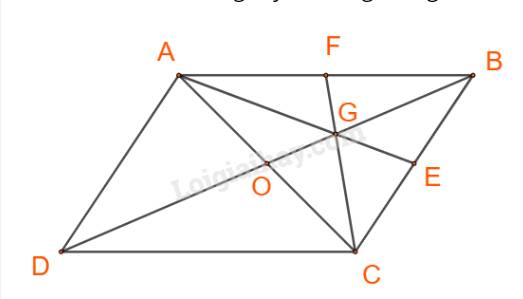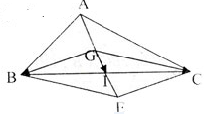Hãy nhập câu hỏi của bạn vào đây, nếu là tài khoản VIP, bạn sẽ được ưu tiên trả lời.

\(T=\overrightarrow{GA}\left(\overrightarrow{BA}+\overrightarrow{AC}\right)+\overrightarrow{GB}.\overrightarrow{CA}+\overrightarrow{GC}.\overrightarrow{AB}\)
\(=\overrightarrow{AB}\left(\overrightarrow{GC}-\overrightarrow{GA}\right)+\overrightarrow{AC}\left(\overrightarrow{GA}-\overrightarrow{GB}\right)\)
\(=\overrightarrow{AB}\left(\overrightarrow{GC}+\overrightarrow{AG}\right)+\overrightarrow{AC}\left(\overrightarrow{GA}+\overrightarrow{BG}\right)\)
\(=\overrightarrow{AB}.\overrightarrow{AC}+\overrightarrow{AC}.\overrightarrow{BA}\)
\(=0\)

Ta có:
\(\overrightarrow {GA} + \overrightarrow {GB} + \overrightarrow {GC} + \overrightarrow {GD} = \overrightarrow 0 \Leftrightarrow \left( {\overrightarrow {GI} + \overrightarrow {IA} } \right) + \left( {\overrightarrow {GI} + \overrightarrow {IB} } \right) + \left( {\overrightarrow {GJ} + \overrightarrow {JC} } \right) + \left( {\overrightarrow {GJ} + \overrightarrow {JD} } \right) = \overrightarrow 0 \)
\( \Leftrightarrow 2\overrightarrow {GI} + \left( {\overrightarrow {IA} + \overrightarrow {IB} } \right) + 2\overrightarrow {GJ} + \left( {\overrightarrow {JC} + \overrightarrow {JD} } \right) = \overrightarrow 0 \)
\( \Leftrightarrow 2\overrightarrow {GI} + 2\overrightarrow {GJ} = \overrightarrow 0 \Leftrightarrow 2\left( {\overrightarrow {GI} + \overrightarrow {GJ} } \right) = \overrightarrow 0 \)
\( \Leftrightarrow \overrightarrow {GI} + \overrightarrow {GJ} = \overrightarrow 0 \Rightarrow \)G là trung điểm của đoạn thẳng IJ
Vậy I, G, J thẳng hàng

Ta đã biết nếu G' là trọng tâm tam giác ABC thì:
\(\overrightarrow{G'A}+\overrightarrow{G'B}+\overrightarrow{G'C}=\overrightarrow{0}\).
Gỉa sử có điểm G thỏa mãn: \(\overrightarrow{GA}+\overrightarrow{GB}+\overrightarrow{GC}=\overrightarrow{0}\).
Ta sẽ chứng minh \(G\equiv G'\).
Thật vậy:
\(\overrightarrow{GA}+\overrightarrow{GB}+\overrightarrow{GC}=\overrightarrow{0}\)
\(\Leftrightarrow3\overrightarrow{GG'}+\overrightarrow{G'A}+\overrightarrow{G'B}+\overrightarrow{G'C}=\overrightarrow{0}\)
\(\Leftrightarrow3\overrightarrow{GG'}=\overrightarrow{0}\)
\(\Leftrightarrow\overrightarrow{GG'}=\overrightarrow{0}\).
Vậy \(G\equiv G'\).

Gọi M là trung điểm BC \(\Rightarrow\overrightarrow{MB}+\overrightarrow{MC}=\overrightarrow{0}\)
Ta có:
\(\overrightarrow{GA}+\overrightarrow{GB}+\overrightarrow{GC}=\overrightarrow{0}\)
\(\Leftrightarrow\overrightarrow{GM}+\overrightarrow{MA}+\overrightarrow{GM}+\overrightarrow{MB}+\overrightarrow{GM}+\overrightarrow{MC}=\overrightarrow{0}\)
\(\Leftrightarrow3\overrightarrow{GM}+\overrightarrow{MA}=\overrightarrow{0}\)
\(\Leftrightarrow\overrightarrow{GM}=\dfrac{1}{3}\overrightarrow{AM}\)
\(\Leftrightarrow\overrightarrow{GA}+\overrightarrow{AM}=\dfrac{1}{3}\overrightarrow{AM}\)
\(\Leftrightarrow\overrightarrow{AG}=\dfrac{2}{3}\overrightarrow{AM}\)
\(\Rightarrow G\) là trọng tâm tam giác ABC

Cách 1:
Gọi O là giao điểm của AC và BD.

Ta có:
\(\begin{array}{l}\overrightarrow {AG} = \overrightarrow {AB} + \overrightarrow {BG} = \overrightarrow a + \overrightarrow {BG} ;\\\overrightarrow {CG} = \overrightarrow {CB} + \overrightarrow {BG} = \overrightarrow {DA} + \overrightarrow {BG} = - \overrightarrow b + \overrightarrow {BG} ;\end{array}\)(*)
Lại có: \(\overrightarrow {BD} =\overrightarrow {BA} + \overrightarrow {AD} = - \overrightarrow a + \overrightarrow b \).
\(\overrightarrow {BG} ,\overrightarrow {BD} \) cùng phương và \(\left| {\overrightarrow {BG} } \right| = \frac{2}{3}BO = \frac{1}{3}\left| {\overrightarrow {BD} } \right|\)
\( \Rightarrow \overrightarrow {BG} = \frac{1}{3}\overrightarrow {BD} = \frac{1}{3}\left( { - \overrightarrow a + \overrightarrow b } \right)\)
Do đó (*) \( \Leftrightarrow \left\{ \begin{array}{l}\overrightarrow {AG} = \overrightarrow a + \overrightarrow {BG} = \overrightarrow a + \frac{1}{3}\left( { - \overrightarrow a + \overrightarrow b } \right) = \frac{2}{3}\overrightarrow a + \frac{1}{3}\overrightarrow b ;\\\overrightarrow {CG} = -\overrightarrow b + \overrightarrow {BG} = -\overrightarrow b + \frac{1}{3}\left( { - \overrightarrow a + \overrightarrow b } \right) = - \frac{1}{3}\overrightarrow a - \frac{2}{3}\overrightarrow b ;\end{array} \right.\)
Vậy \(\overrightarrow {AG} = \frac{2}{3}\overrightarrow a + \frac{1}{3}\overrightarrow b ;\;\overrightarrow {CG} = - \frac{1}{3}\overrightarrow a - \frac{2}{3}\overrightarrow b .\)
Cách 2:
Gọi AE, CF là các trung tuyến trong tam giác ABC.

Ta có:
\(\overrightarrow {AG} = \frac{2}{3}\overrightarrow {AE} = \frac{2}{3}.\frac{1}{2}\left( {\overrightarrow {AB} + \overrightarrow {AC} } \right) = \frac{2}{3}.\frac{1}{2}\left[ {\overrightarrow {AB} + \left( {\overrightarrow {AB} + \overrightarrow {AD} } \right)} \right] \\= \frac{1}{3}\left( {2\overrightarrow a + \overrightarrow b } \right) = \frac{2}{3}\overrightarrow a + \frac{1}{3}\overrightarrow b \)
\(\overrightarrow {CG} = \frac{2}{3}\overrightarrow {CF} = \frac{2}{3}.\frac{1}{2}\left( {\overrightarrow {CA} + \overrightarrow {CB} } \right) = \frac{2}{3}.\frac{1}{2}\left[ {\left( {\overrightarrow {CB} + \overrightarrow {CD} } \right) + \overrightarrow {CB} } \right] = \frac{1}{3}\left( {2\overrightarrow {CB} + \overrightarrow {CD} } \right) = \frac{1}{3}\left( { - 2\overrightarrow {AD} - \overrightarrow {AB} } \right) = - \frac{1}{3}\overrightarrow a - \frac{2}{3}\overrightarrow b \)
Vậy \(\overrightarrow {AG} = \frac{2}{3}\overrightarrow a + \frac{1}{3}\overrightarrow b ;\;\overrightarrow {CG} = - \frac{1}{3}\overrightarrow a - \frac{2}{3}\overrightarrow b .\)

Ta có \(AC = AB\sqrt 2 = a\sqrt 2 \)
+) \(\overrightarrow {KA} + \overrightarrow {KC} = \overrightarrow 0 \),
Suy ra K là trung điểm AC \( \Rightarrow AK = \frac{1}{2}.a\sqrt 2 = \frac{{a\sqrt 2 }}{2}\)
+) \(\overrightarrow {HA} + \overrightarrow {HD} + \overrightarrow {HC} = \overrightarrow 0 \), suy ra H là trọng tâm của tam giác ADC
\(\Rightarrow DH = \frac{2}{3}DK = \frac{1}{3}DB\) (1)
+) \(\overrightarrow {GA} + \overrightarrow {GB} + \overrightarrow {GC} = \overrightarrow 0 \), suy ra G là trọng tâm của tam giác ABC

\(\Rightarrow BG = \frac{2}{3}BK = \frac{1}{3}BD\) (2)
\((1,2) \Rightarrow HG = \frac{1}{3}BD=\frac{{a\sqrt 2 }}{3}\)
Mà \(KG = KH = \frac{1}{2}HG= \frac{{a\sqrt 2 }}{6}\) (2)
\(\Rightarrow AG = \sqrt {A{K^2} + G{K^2}} = \sqrt {{{\left( {\frac{{a\sqrt 2 }}{2}} \right)}^2} + {{\left( {\frac{{a\sqrt 2 }}{6}} \right)}^2}} = \frac{{a\sqrt 5 }}{3}\)
\( \Rightarrow \left| {\overrightarrow {AG} } \right| = \frac{{a\sqrt 5 }}{3}\)
Vậy \(\left|\overrightarrow {KA}\right| =\frac{{a\sqrt 2 }}{2} ,\left|\overrightarrow {GH}\right|=\frac{{a\sqrt 2 }}{3} ,\left|\overrightarrow {AG}\right|=\frac{{a\sqrt 5 }}{3} \).

Lời giải:
a) Gọi giao của hai đường chéo là $I$ thì $I$ là trung điểm của $AD$ và $BC$
Do đó, \(A,G,I,D\) thẳng hàng. Áp dụng tính chất của đường trung tuyến:
\(\bullet \overrightarrow{GA}=\frac{-1}{3}\overrightarrow{AD}\)
\(\bullet \overrightarrow{GB}=\overrightarrow{GA}+\overrightarrow{AB}\)
\(\bullet \overrightarrow{GD}=\frac{2}{3}\overrightarrow{AD}\)
\(\Rightarrow \overrightarrow{GA}+\overrightarrow{GB}+\overrightarrow{GD}=2\overrightarrow{GA}+\overrightarrow{AB}+\overrightarrow{GD}=\frac{-2}{3}\overrightarrow{AD}+\overrightarrow{AB}+\frac{2}{3}\overrightarrow{AD}\)
\(\Leftrightarrow \overrightarrow{GA}+\overrightarrow{GB}+\overrightarrow{GD}=\overrightarrow{AB}\)
b) Áp dụng công thức phần a:
\(\overrightarrow{GA}+\overrightarrow{GB}+\overrightarrow{GM}=\overrightarrow{AD}\)
\(\Leftrightarrow \overrightarrow{AB}-\overrightarrow{GD}+\overrightarrow{GM}=\overrightarrow{AD}\)
\(\Leftrightarrow \overrightarrow{GM}-\overrightarrow{GD}=\overrightarrow{AD}-\overrightarrow{AB}\)
\(\Leftrightarrow \overrightarrow{DM}=\overrightarrow{BD}\)
Do đó $M$ là điểm nằm trên đường thằng $BD$ sao cho $D$ là trung điểm của $BM$
* câu a hình như sai rồi đó bn
* câu b mk đọc o hiểu j hết